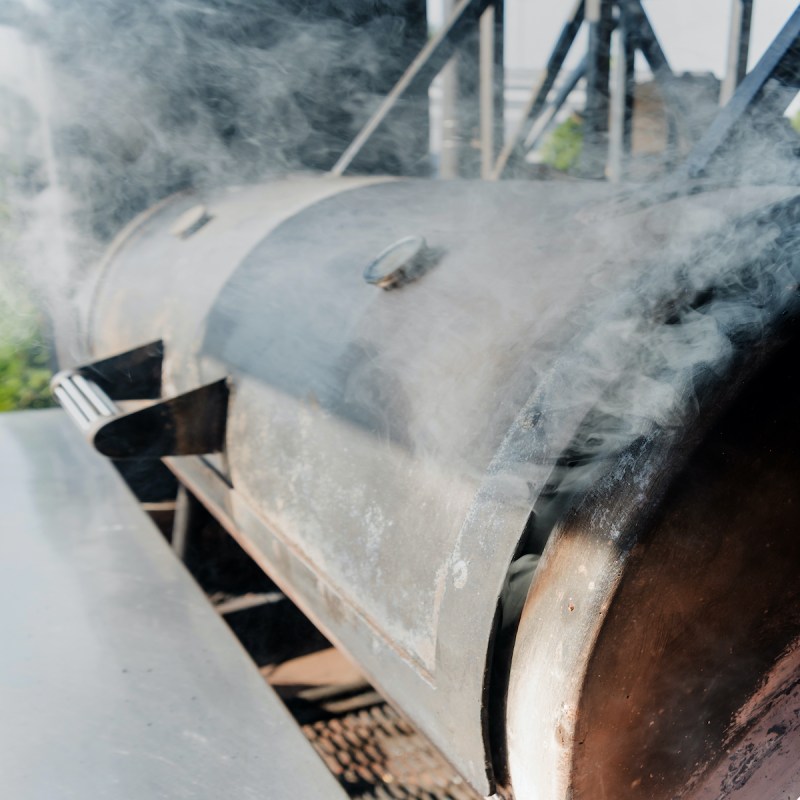
North and South Carolina may share a last name, but as with all couples, they are also individuals and have had their share of disagreements. In the 1700s, it was about boundaries. Today, it’s college football and barbecue.
Videos by TravelAwaits
The Carolinas share a border that runs from the mountains to the Atlantic Coast. North Carolina has more in the way of mountains, but with a total of 54,000 square miles, to the 32,000 that comprise South Carolina, somebody has to have more of something. But when it comes to barbecue, each state claims to have the most and the best.
Carolinians — North and South — love their barbecue, but the quarreling tends to be good natured and much quieter than football arguments. After all, their mamas taught them not to talk with their mouths full.
The barbecue debate is complicated, and there are at least as many similarities as there are differences. For one thing, wherever you are, barbecue has to be slow smoked over wood or coals overnight. A cooking time of 12 to 16 hours is the norm. For another, many barbecue joints go back several generations, and the recipes are originals. Also, the sauces have to be homemade. If you enter a barbecue joint in either state and see supermarket brands on the tables, run.
The barbecue rivalry between the Carolinas may be friendly, but it’s real. So, if you plan to venture into the delectable world of barbecue in either or both states, here are several key points to keep in mind.

1. Historical Perspective
Many South Carolinians believe barbecue was born in their state, but North Carolina has history on its side.
Sir Walter Raleigh made an important discovery in the late 16th century. In a sketch he saw of coastal Croatan Indians cooking fish, he noticed how they smoked their food using a “barbacoa,” a framework of sticks supporting food over a fire. And the rest is history.

2. Regional Divisions
When it comes to Carolina barbecue, what you eat depends as much on the part of the state you’re in as on the state itself. North Carolina may be larger in square miles, but South Carolina offers twice as many regional barbecue profiles.
In North Carolina, there are two distinct styles of barbecue: Eastern style, found along the coast, and Lexington, in the Piedmont and West. Eastern pitmasters cook the entire hog, while Lexington barbecue purists use only the shoulder sections. A popular phrase is, “Easterners cook every part of the pig except the squeal.” No doubt, the rest of the pig doesn’t go to waste in the west either. It’s just not invited into the pit.
South Carolina pitmasters cook as much of the pig as they choose, but they crown their meat with four different sauces in four different parts of the state.
Don’t eat pork? You can always order barbecue chicken almost everywhere. You can even find brisket and turkey in some restaurants, and it will be just as delectable as what the pig has to offer.

3. The Secrets Are In The Sauces
Perhaps the biggest bone of contention between the two Carolinas is who has the best sauce. North Carolina uses two traditional sauces, depending on whether you’re eating Eastern or Lexington-style barbecue. South Carolina claims four sauces as her own, but the geographic lines aren’t as easily defined.
Eastern-style North Carolina barbecue sauce is thin, vinegar-based, and flavored with a small amount of sugar and a larger amount of red pepper. Lexington or Piedmont style sauce is similar, but with the addition of tomato or ketchup.
South Carolina has four basic sauces. The bright yellow, tangy, and slightly sweet mustard-based sauce, common in the central part of the state, is the best known. The sauce of the coastal region follows the main recipe used in Eastern North Carolina but omits the sugar. Influenced by North Carolina’s Lexington-style, a light tomato sauce can be found in South Carolina’s Piedmont and upper Midlands. If you prefer a heavy tomato sauce, you’ll find it in western and northwestern parts of the state.
All the sauces in both states have some heat, but South Carolina’s tend to be hotter. If the word “honey” appears in the sauce name, neither Carolina will claim it.

4. The Sides
Sides are an integral part of the total barbecue experience. Both Carolinas, along with their various regions, agree on several standards, such as coleslaw, hush puppies, baked beans, mac and cheese, and fries. But each state likes to throw in at least one side to make sure you know where you are.
In North Carolina, you will often find Brunswick Stew on the long list of sides. This is a thick stew made of chicken, pork, tomatoes, butter beans, creamed corn, potatoes, and whatever else the cook decides to throw into the pot.
In South Carolina, you’re likely to find Barbecue Hash. Although like Brunswick Stew, the final product varies from restaurant to restaurant, the basic premise is boiling meat, usually shredded barbecue, potatoes, onions, barbecue sauce, and mustard until it’s truly dead. Then pureeing it, adding seasonings, and cooking it some more. The consistency is similar to a thick, heavy soup, and it’s usually served over rice. Sound disgusting? I thought so, too, until I tasted it out of politeness. The flavors were balanced to the point where I couldn’t distinguish one from another, and it went down like comfort food should. I encourage you to close your eyes and give it a try.
As for the standard sides, slaws and beans often vary greatly in ingredients from region to region. So expect a few surprises.

5. Carolina BBQ Trails
Each of the Carolinas has an official barbecue trail that showcases the crown jewels of the state’s culinary persona. But, as expected, each state has its own view of what the path to barbecue Nirvana should contain. To be included on North Carolina’s trail, a restaurant has to meet a strict set of qualifications. While in South Carolina, you simply have to make good barbecue.
The North Carolina Barbecue Society Historic Barbecue Trail® (NCBS) has created a barbecue trail that runs from Eastern North Carolina to the Tennessee state line. The trail crosses the state with 20 stops at designated NCBS Historic Barbecue Pits. The NCBS board selected them because they clearly represent North Carolina’s distinctive methods and cooking styles. Each barbecue pit on the trail displays an NCBS emblem indicating it has met certain criteria, such as providing sit-down dining. No town or city can have more than two restaurants on the trail. An interactive map of the trail is available online. It provides a photo and link to each establishment.
Whereas North Carolina believes that less is more when it comes to barbecue trails, South Carolina has decided more is better. The South Carolina barbecue trail map, courtesy of the South Carolina Department of Tourism, is a comprehensive resource for hungry road trippers. The map divides the state into territories, identifying over 200 barbecue restaurants. A quick look at the map yields a wealth of information: restaurant name, address, phone number, website, and hours of operation of each.

6. Festivals
Carolinians look forward to their barbecue festivals. Some involve competitions, while others use the opportunity to flaunt the best their area of the state has to offer.
Every October, the town of Lexington, North Carolina, is host to the North Carolina Barbecue Festival. Over 150,000 visitors descend upon Lexington to indulge in over 11,000 pounds of slow smoked meat, along with all the trimmings. A carnival atmosphere accompanies the barbecue with games, races, sculptures, and music. This one-day party offers the opportunity to work up an appetite with the 5K Hog Run, thrill to a BMX stunt show, and smile at the dog teams as they show off their skills.
In South Carolina, one of the premier events is a festival/competition, the South Carolina Festival of Discovery, held every July in the upstate town of Greenwood. The festival celebrates the history, culture, food, arts, crafts, music, and people of South Carolina in general and Greenwood County in particular. The Kansas City Barbeque Society (KCBS) barbecue and Hash Cook-Off allows attendees to sample traditional barbecue at its best, and even though this is a serious competition, the flavors, and textures are all winners. And while you’re sampling the barbecue, enjoy “Blues Cruise,” a celebration of the genre, with numerous artists performing throughout the two-day festival.
Now that you know the key differences between North and South Carolina barbecue, be aware that there are many pitmasters in both states who pride themselves on shaking things up. For example at Fowler’s Southern Gourmet in Fayetteville, North Carolina, you can try poutine with brisket, blueberry-infused barbecue sauce, and a variety of other delightful innovations.
So, enjoy the Carolina traditional fare, but don’t be afraid to try something new.
Sample barbecue when you visit the Carolinas, but here are some other restaurant recommendations for both states:
